7 Cloud-Based Tools Revolutionizing Construction Project Management in 2025
Taher Pardawala May 12, 2025
Cloud-based tools are transforming construction project management in 2025, helping teams save time, reduce costs, and improve safety. From AI-powered scheduling to real-time collaboration, these tools are addressing challenges like labor shortages, material delays, and communication gaps.
Here’s a quick look at the top tools driving change:
- Procore: AI-driven automation reduces rework by 75% and improves safety by 79%.
- Autodesk Construction Cloud: Mobile-first platform with AI tools like Construction IQ for risk prediction.
- Buildertrend: Focuses on residential construction with predictive scheduling and inventory management.
- CoConstruct: Streamlines client and trade partner communication with a single-entry system.
- Oracle Aconex: Offers a secure, centralized data environment for large-scale projects.
- Smartsheet: Enhances real-time collaboration with mobile forms, issue tracking, and AI analytics.
- Fieldwire: Optimizes on-site workflows with task management and BIM integration.
These tools are reshaping how construction teams plan, execute, and manage projects, making them more efficient and connected than ever before.
5 Cloud Based Softwares For Your Construction Business
1. Procore
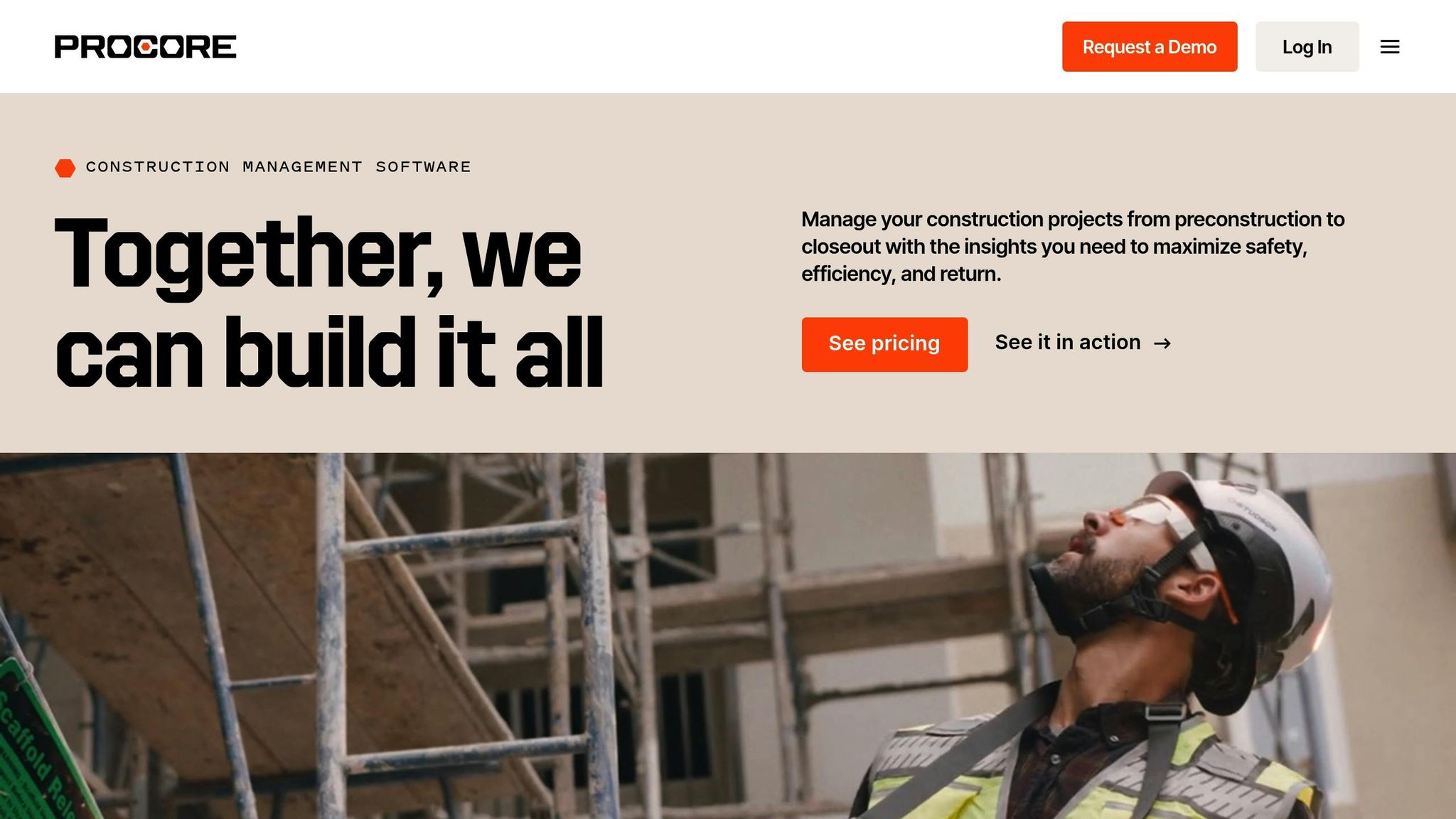
Procore is transforming how construction projects are managed, tackling industry challenges with tools that focus on smart automation, data insights, and better teamwork. Its 2025 vision revolves around making processes smoother and more efficient through cutting-edge technology.
The platform’s AI suite – featuring Agents, Insights, and Copilot – allows teams to tailor AI solutions without any coding knowledge. This helps automate repetitive tasks and simplifies workflows.
"Procore AI delivers the most comprehensive set of AI capabilities in construction today, unlocking new ways for construction to build together", says Steve Davis, president of product and technology at Procore [2].
Procore’s ability to enhance project efficiency is evident in these key metrics:
| Performance Metric | Improvement |
|---|---|
| Project Volume Management | 48% more per person |
| Rework Reduction | 75% of users report a reduction |
| Schedule Savings | Average 15 days per project |
| Safety Program Enhancement | 79% improvement reported |
| Field-to-Office Communication | 90% improvement rate |
These numbers highlight how Procore improves both safety and efficiency. For instance, Dolan Concrete, based in the U.S., has saved a significant amount of time using Procore’s unified platform. Gabriel Gutierrez, their Financial Controller, shares:
"Procore saves me at least two hours every week. In the past, I’d spend the first two hours of my day reconciling data across systems. Now, all that’s taken care of for me in a few clicks. We’re talking about a total of 30 seconds." [4]
Procore’s communication tools are another standout feature. Victory Woodworks, Inc. leveraged the Correspondence tool in Q3 2023 to speed up issue resolution by linking critical documents – like plans, specs, and photos – directly to RFIs. This streamlined their approval process significantly.
"With Procore’s Correspondence tool, we can elevate key communications outside of email and place them in their own, more formal system of record. This enables us to get the attention and response we need when issues or delays threaten to impact the project", explains Matthew Slaughter, Project Manager at Victory Woodworks, Inc. [3].
Procore also delivers value for owners and developers, increasing capital project management capacity by 45% per person and standardizing 61% more processes [5]. Its mobile tools give teams real-time access to project details, boosting field crews’ ability to document and communicate site issues by 58% [5].
"If we didn’t have Procore, we wouldn’t be able to handle the many projects we have in our pipeline. Procore removes the tedious time-wasters like filling out reports and spreadsheets, giving us time to do other things, like going after more work", says Marc Vicano, Project Manager at Vicano, a General Contractor in Canada [4].
Procore’s innovations are raising the bar for cloud-based construction project management.
2. Autodesk Construction Cloud (PlanGrid)
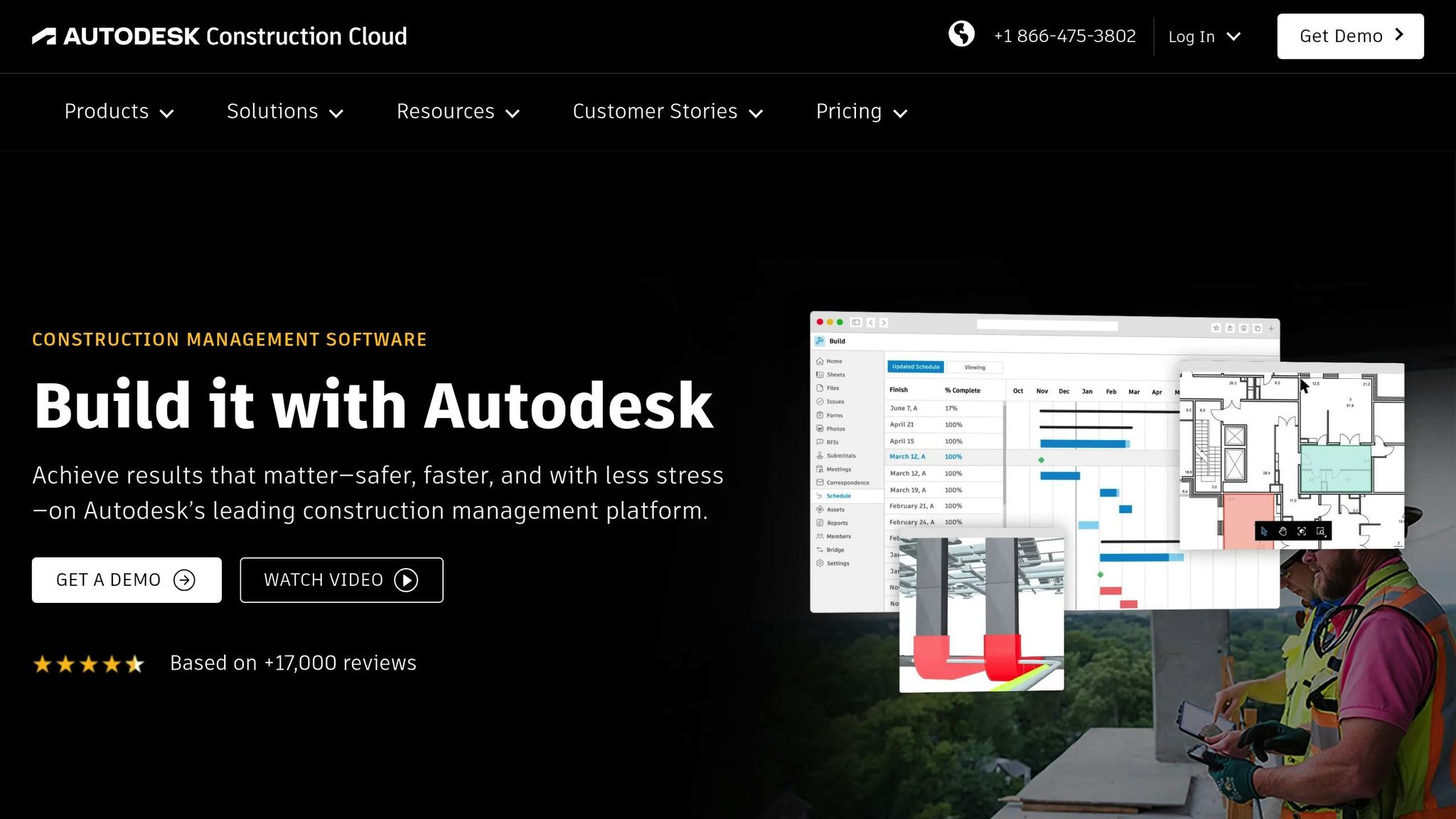
Autodesk Construction Cloud (ACC) has changed the game for construction teams by streamlining communication between the field and the office. With its mobile-first approach, teams can access the latest project data – including drawings, documents, and models – anytime, anywhere.
The impact is clear when looking at real-world success stories. For instance, Oahu Metal & Glazing managed to slash their project kickoff time by an impressive 75% using Autodesk Build. Similarly, S. M. Wilson & Co. improved efficiency by integrating RFIs, issues, sheets, and photos into a single, unified workflow [6].
ACC’s AI-powered tools bring even more to the table:
- Construction IQ: Identifies and prioritizes risks by analyzing project data.
- Autodesk Assistant: A conversational AI that speeds up information searches.
- AutoSpecs: Simplifies submittal log creation by automating the process.
- Photo AI: Organizes construction photos by automatically tagging them.
Amy Kozlowski, Project Manager at Herrero Builders, highlights the time-saving benefits of ACC:
"Time is one of the most valuable assets in construction. When you have everybody on the same interface, you can seamlessly and efficiently communicate across all platforms. Autodesk Build is going to save time by eliminating redundancies and having one platform that I need to open to convey information across the entire team."
– Amy Kozlowski, Project Manager at Herrero Builders [6]
One standout feature, "Ball in Court", enhances cross-team collaboration by clearly tracking third-party assignments. Modular Power Solutions leveraged this feature, along with AI categorization and customizable fields, to standardize their workflows and gain better visibility into project progress [6].
The platform’s document management tools are another major advantage. With advanced version control, markup capabilities, and status tracking, stakeholders can be confident they’re always working with the most up-to-date information. Plus, the ability to connect 2D and 3D models directly to mobile devices ensures that teams in the field have complete project context at their fingertips [6].
BOLDT company has also benefited from ACC, using Autodesk Build to centralize project information, improve transparency, and enhance team visibility. By combining this centralization with Construction IQ’s analytics, they’ve been able to reduce risks tied to project quality, safety, and design reviews [7].
As more than 66% of business leaders predict AI will become essential in the next 2–3 years, ACC is already ahead of the curve. Its suite of AI tools not only automates repetitive tasks but also provides predictive insights to help teams stay proactive [8].
3. Buildertrend
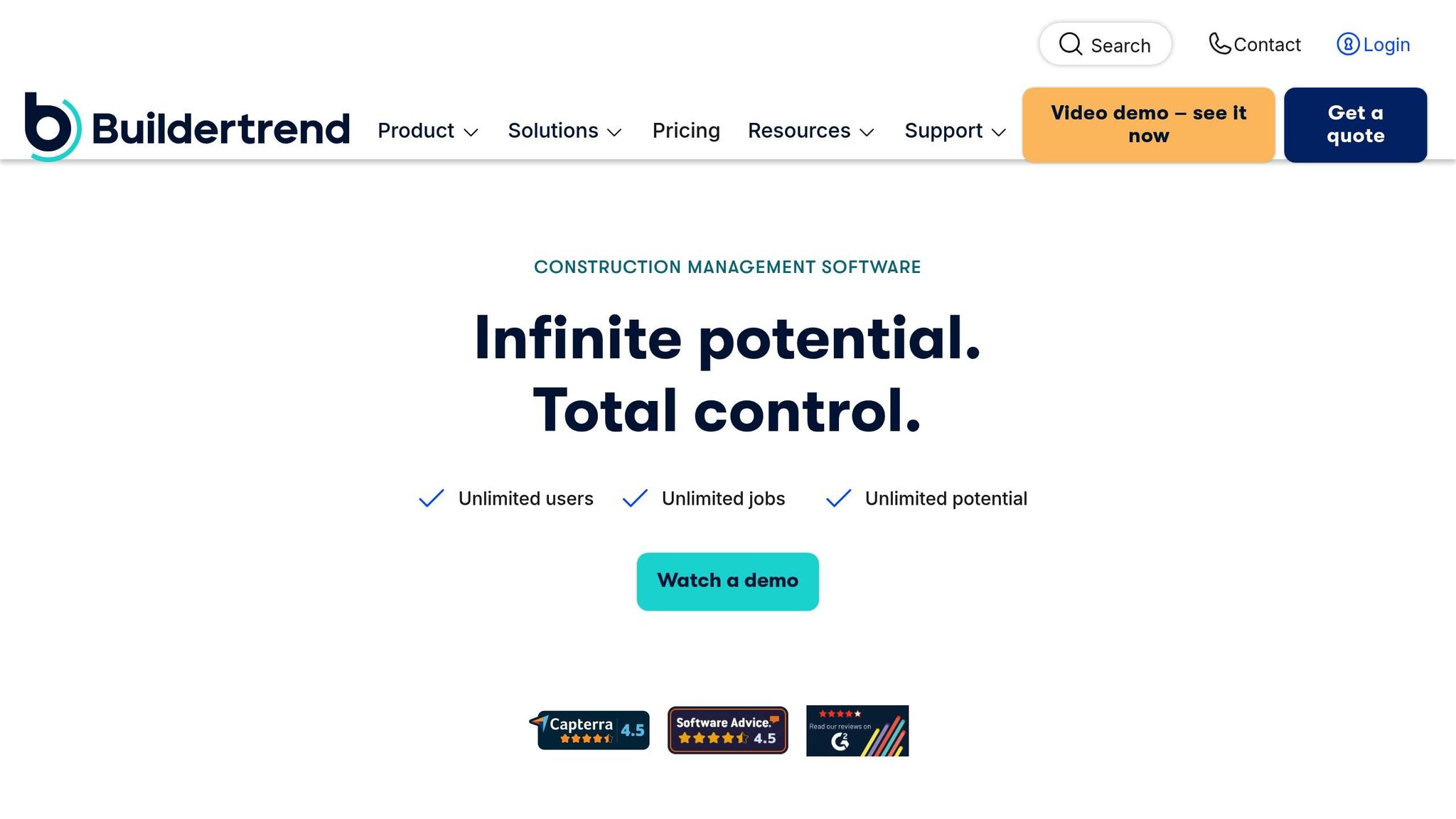
Buildertrend has made a name for itself in residential construction management, offering a cloud-based platform that supports over 1 million users worldwide. It combines advanced project management tools with cutting-edge technology to address common challenges in the construction industry [9].
Delays in construction projects remain a significant issue. Recent statistics reveal an average project delay of 46.8 days – a 117.5% increase compared to the previous year [11]. Buildertrend tackles these setbacks with AI-powered tools designed to optimize schedules and predict delays before they disrupt progress.
Material delays have been especially severe, with siding delayed by 17 days (+183.3%), windows by 13 days (+333.3%), doors by 12 days (+200%), framing by 10 days (+233.3%), and roofing by 9 days (+200%) [11]. Buildertrend’s predictive scheduling and inventory management tools help teams navigate these challenges more effectively.
The platform’s AI-driven features enhance essential construction processes [10]:
- Automated inventory management that predicts material needs
- Smart financial tools for streamlined invoicing and budgeting
- AI chatbots for instant client communication
- Intelligent scheduling optimization to reduce project delays
Buildertrend has delivered measurable results for businesses. Monty Brock, managing partner at DMJ Restorations and DMJ Design Build, highlights how the platform has improved their operations:
"Our margins have really improved. Right now, I would say it’s very rare we don’t hit our targeted margins. It’s because of our budgeting and change order process. In the past, we might have had three good jobs and one oops. Everything’s tightened up today." [9]
The platform also excels in client communication. Matt Troyer, Founder and CEO of Emergent Construction, shares how the Customer Portal has transformed interactions:
"We use the Customer Portal for payments, communication and everything else with our clients. Buildertrend delivers clear, organized communication that enhances client understanding." [9]
For businesses aiming to scale, Buildertrend’s systematic approach has proven effective. Tyler Farrell, president of Killowen Construction, explains how the platform supported his company’s growth:
"By trying to take everything out of my mind and put it into a system my people could relate to and operate well in, [Buildertrend’s] tools were really important with helping me scale." [12]
Beyond operational improvements, Buildertrend has helped companies save money. Paul McManus, Founder of McManus Kitchen and Bath, reports saving $1,800 annually by eliminating the need for separate CRM and time-tracking software [9]. These cost savings, combined with its robust features, make Buildertrend a valuable ally for construction businesses tackling modern challenges.
4. CoConstruct
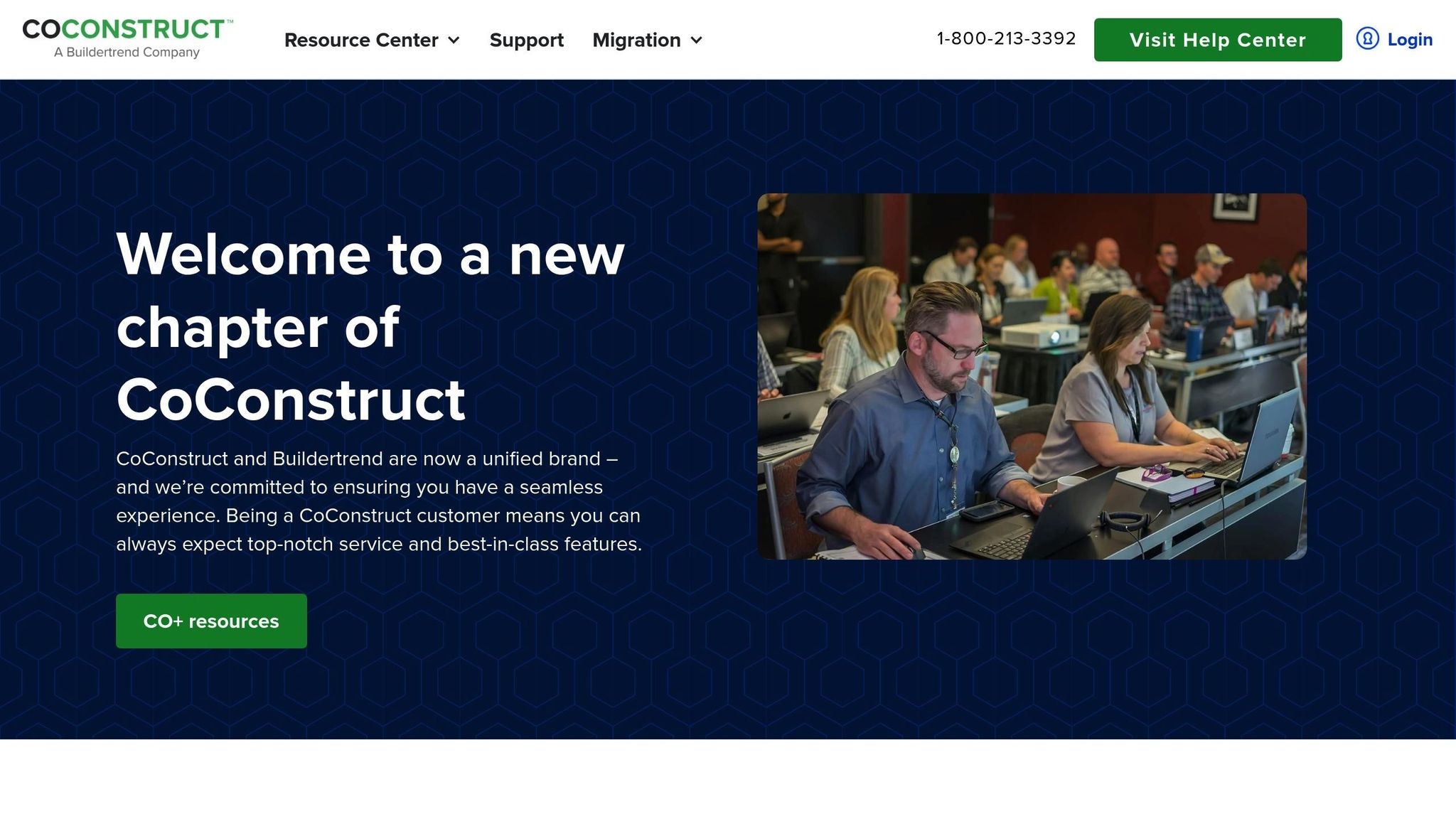
CoConstruct is a cloud-based project management platform trusted by over 100,000 building professionals [16]. Its standout feature is a single-entry system that ensures data flows smoothly across all aspects of project management [13].
The platform offers integrated financial planning with pricing tiers that range from $49 to $499 per month, depending on the number of active job sites. This setup means companies only pay when they secure a contract [13]. CoConstruct also fosters real-time collaboration by providing a unified hub where builders, clients, and trade partners can connect – no extra logins required [13]. These tools give businesses better control over their projects. Users frequently praise its customer support, which has earned an impressive rating of 9.8 out of 10 [13].
Key Features of CoConstruct
| Feature | Benefit |
|---|---|
| 24/7 Client Access | Clients can view selections, costs, job logs, photos, and conversations in real time [14]. |
| Trade Partner Integration | Assign tasks and send automated summary emails to trade partners [15]. |
| Warranty Management | Streamlines client-submitted requests with a built-in verification system [14]. |
| Document Control | Allows selective visibility of documents for subcontractors and clients [16]. |
CoConstruct excels at centralizing project communication. According to the platform:
"Put an end to jumbled emails and find all of your project communication in seconds. Fewer misunderstandings, clearer communication and more time spent doing – that’s what communication in CoConstruct looks like." [14]
Tips for Maximizing CoConstruct
- Use selection sheets for client decisions instead of relying on messages [15].
- Keep all communication within the platform to ensure complete project documentation [15].
- Organize client notes effectively using the "Move" feature [15].
While CoConstruct offers a robust set of tools, some users have pointed out areas for improvement, such as internal communication features like @mentions and lead tracking [13]. Still, with unlimited storage, user access, and warranty projects, along with dedicated coaching and support, CoConstruct remains a powerful tool for streamlining operations and improving project outcomes in 2025.
sbb-itb-51b9a02
5. Oracle Aconex
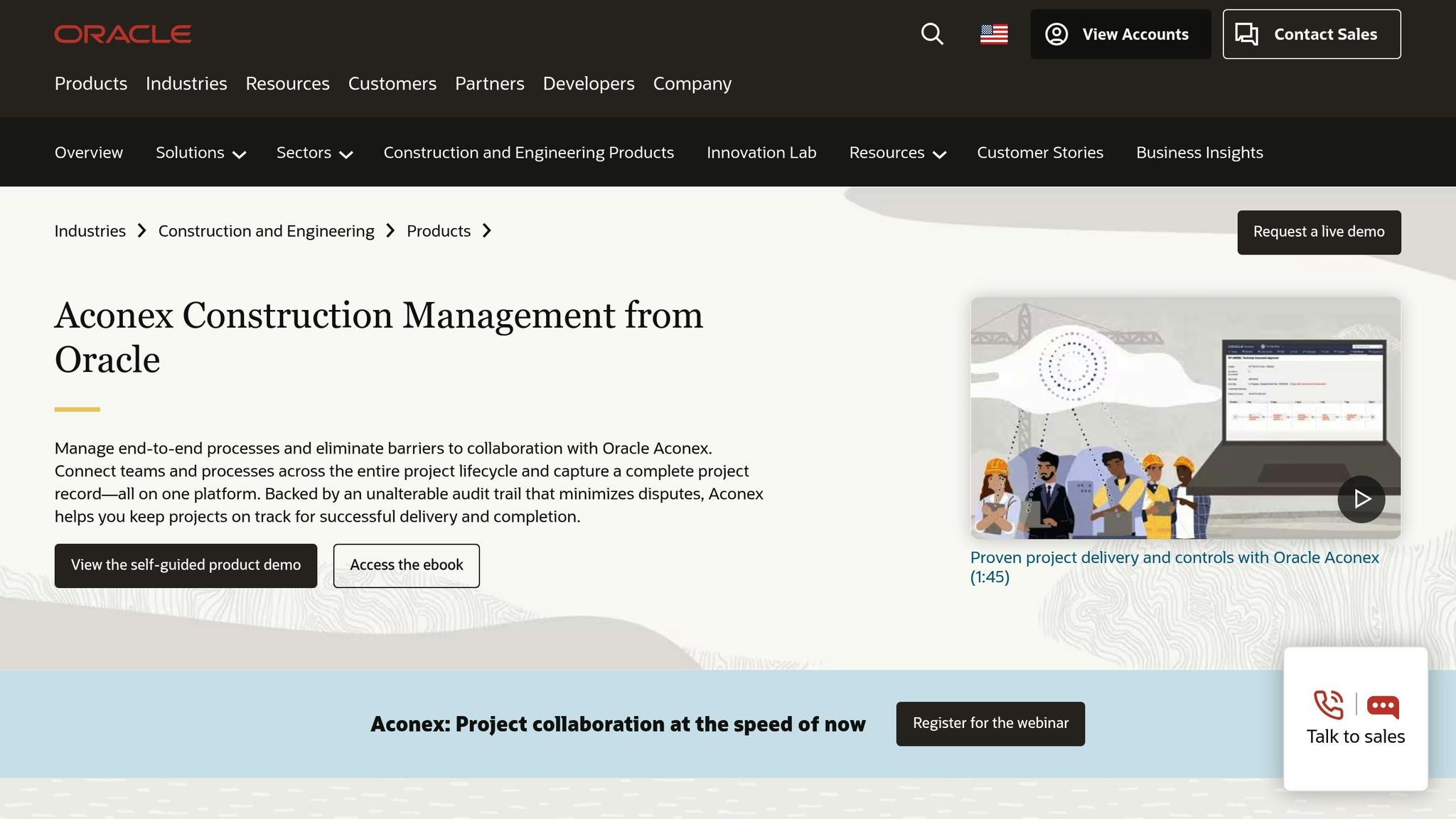
Oracle Aconex bridges the gap between teams and processes throughout the entire project lifecycle. Its unique data ownership model ensures smooth collaboration by breaking down communication barriers and enabling effortless information sharing.
With features designed to simplify document management, streamline workflows, and handle contractor relationships, Oracle Aconex offers a comprehensive solution for project teams.
Integrated Project Management Features
The platform provides a common data environment (CDE) packed with tools tailored for managing complex projects. Here’s a quick look at some of its standout features:
| Feature | Function | Benefit |
|---|---|---|
| Document Register | Centralized repository for all project documents | Prevents version discrepancies |
| Automated Workflows | Standardized processes for approvals and reviews | Speeds up task completion |
| Tender Management | Secure platform for bid handling | Simplifies contractor selection |
| Mobile Access | Real-time updates and data sharing | Bridges the gap between field teams and office staff |
Real-World Success Story
Siemens Gamesa turned to Oracle Aconex for its offshore windfarm projects and achieved remarkable results, including saving up to 5,000 working hours per project on document-related tasks [17]. Oracle highlights the platform’s capabilities:
"Manage end-to-end processes and eliminate barriers to collaboration with Oracle Aconex. Connect teams and processes across the entire project lifecycle and capture a complete project record – all on one platform." – Oracle [17]
Mobile Capabilities
Oracle Aconex Mobile is specifically designed to empower on-site teams with tools that keep them connected and efficient. Some of its key functionalities include:
- Real-time access to documents, emails, and 3D models
- Automated inspections and safety walk-throughs
- Quick logging and resolution of on-site issues
- Digital data capture for seamless updates
The platform also integrates with Oracle Primavera Cloud, ensuring all project stakeholders work from a unified dataset. This integration minimizes errors and enhances decision-making. As Oracle emphasizes:
"Eliminate barriers to collaboration and connect teams with a unique data ownership model that maximizes adoption, collaboration, and data sharing across the entire project, creating a complete project record in one system." – Oracle [17]
6. Smartsheet

Smartsheet is making waves in construction management by offering cloud-based tools that enhance team collaboration and project oversight. With over 3 million users in 190 countries, it’s a platform that’s changing the way construction teams work together [19].
Real-Time Collaboration Features
Smartsheet bridges the gap between field teams and office staff, ensuring seamless communication and coordination. Here’s how its features deliver:
| Feature | Purpose | Impact |
|---|---|---|
| Mobile Forms | Collects field data | Minimizes errors and keeps reporting consistent |
| Issue Tracking | Identifies problems instantly | Speeds up resolution and reduces delays |
| Resource Dashboard | Monitors performance | Offers immediate insights into project progress |
| Document Hub | Manages files centrally | Simplifies access to essential project documents |
AI-Powered Project Management
Smartsheet integrates AI tools to help construction teams work smarter, not harder. Its capabilities include:
- Generating complex formulas for calculations.
- Automating text summaries for reports.
- Analyzing project data to uncover actionable insights.
- Streamlining repetitive tasks to save time.
Mobile Functionality for Field Teams
The Smartsheet mobile app is a game-changer for on-site teams, offering tools that make fieldwork more efficient:
- QR Code Scanning: Quickly report issues by scanning codes on-site.
- GPS Location Tracking: Add precise location data to documentation.
- Mobile-Friendly Forms: Simplify data collection directly from the field.
- Inspection Logs: Keep detailed records of inspections in real time.
This mobile-first approach ensures that field teams stay connected and productive, no matter where they are.
"For construction companies, Smartsheet delivers increased project efficiency and accountability by streamlining communication and documentation, ultimately boosting safety and profits." [19]
Project Control Center
Smartsheet centralizes key project management tasks, giving teams the tools they need to stay on track:
- Schedule Management: Teams can monitor timelines, dependencies, and milestones in real time.
- Budget Tracking: Keep a close eye on costs, bids, and permits to avoid surprises [18].
- Resource Optimization: Dashboards and self-service reports provide instant insights into resource use and performance [19].
Field Implementation Best Practices
To get the most out of Smartsheet, construction teams can follow these tips:
- Set up desktop views before rolling out mobile tools.
- Use barcode scanning for faster inventory management.
- Enable GPS tracking to ensure accurate site documentation.
- Develop standardized mobile forms for consistent data entry.
Smartsheet’s real-time updates and AI-driven tools keep everyone on the same page, ensuring smoother operations and better outcomes.
7. Fieldwire

Fieldwire is reshaping construction management with its powerful on-site tools, already trusted on over 2 million jobsites worldwide. It enables teams to collaborate in real time, ensuring smoother workflows and better communication [20].
By building on earlier cloud-based tools, Fieldwire takes on-site efficiency to the next level with its extensive feature set.
Advanced Tools for Field Management
Fieldwire comes packed with features that simplify construction operations and tackle common challenges:
| Feature | Function | Benefit |
|---|---|---|
| Digital Plans | Access and annotate blueprints in real time | Resolves version control problems |
| Task Management | Assign tasks and track progress | Enhances team coordination |
| QR Code System | Access site-specific data instantly | Speeds up navigation on-site |
| BIM Integration | View 3D models and object trees | Improves spatial understanding |
| Custom Forms | Digitize documentation and reporting | Cuts down on paperwork |
Saving Time and Boosting Productivity
Fieldwire has proven to save users an average of 5.2 hours every week by streamlining processes and improving communication. It also boasts a 98% customer support satisfaction rate, demonstrating its reliability [22].
Real-World Success Stories
Fieldwire’s impact is evident in its real-world applications, with major construction companies reporting impressive results:
Assemblin’s Experience: This technical installation company reduced working time by 25% after adopting Fieldwire. They used it on large-scale projects like the European Spallation Source in Lund, Sweden, where they installed over 1.5 million meters of cable [23][24].
"Fieldwire has definitely helped us become more efficient. By being able to keep track of our actions, we no longer need to go back and check every time. In this sense, Fieldwire has allowed us to overcome critical jobsite management challenges." – Bogi Einarsson, Project Lead [23][24]
Managing Large-Scale Projects
Fieldwire is particularly effective for enterprise-level construction projects. Here are a few examples of its success:
- Webcor Builders: Managed the $500 million Moscone Center expansion in San Francisco [20].
- Clark: Coordinated the construction of an 83,000-square-foot tech hub at Washington State University [20].
- EllisDon: Simplified operations for the $800 million Providence Care Hospital project [20].
In addition to handling massive projects, Fieldwire integrates with essential business tools, making it a comprehensive solution.
Seamless Integration with Business Tools
Fieldwire connects effortlessly with widely used tools, including:
- Microsoft Teams for team communication
- Outlook for scheduling
- Google Calendar for timeline management
- Entra ID for secure access [21]
Designed for Mobile Teams
Fieldwire’s mobile-first approach ensures that teams can stay connected and productive, even on the go. Key mobile features include:
- Annotating blueprints directly on-site
- Capturing and documenting defects with photos
- Processing change orders via email
- Monitoring project progress in real time [21]
"With the Fieldwire web and mobile apps, construction workers were able to seamlessly communicate with their peers, view and annotate blueprints from the jobsite, manage tasks, and document defects." – Stéphane Denerolle, VP of Product [22]
Conclusion
The construction industry in 2025 is navigating a landscape marked by rising material costs and increasingly complex projects. However, cloud-based tools are stepping in to tackle these challenges with data-driven solutions that are reshaping the way construction operates.
Addressing Industry Challenges with Measurable Results
Cloud-based construction management tools are offering tangible benefits that directly address key industry challenges:
| Challenge | Solution | Benefit |
|---|---|---|
| Labor Shortage | AI-powered automation | 30% boost in construction efficiency [26] |
| Material Costs | IoT-enabled supply chain | $1.2 trillion in potential annual savings [26] |
| Project Delays | Real-time monitoring | Improved timeline accuracy and predictability |
| Communication | Digital collaboration | Reduced rework and better coordination |
These advancements are not just solving immediate issues – they’re paving the way for a workforce equipped to meet future demands.
Shaping the Workforce of Tomorrow
AI and cloud technologies are redefining how construction teams operate. Sasha Reed, Senior Director of Industry Transformation at Procore, highlights this shift:
"Investing in our workforce isn’t just about training for today – it’s about redefining the skills needed to deliver modern projects effectively, into the future. Capturing practical know-how to build curriculum and create an embedded experience for hands-on work is now possible with AI" [1].
By integrating AI, companies can bridge the gap between traditional expertise and the digital skills required for modern construction.
Enhancing Construction Operations for the Future
Cloud-based tools are enabling firms to streamline operations and anticipate challenges. Here’s how they’re making an impact:
- Predictive analytics help mitigate weather-related disruptions and delays.
- IoT devices enhance on-site safety by providing real-time monitoring.
- AI automation reduces the burden of repetitive tasks.
- Digital checklists standardize processes and improve consistency [25].
Platforms like Procore, Autodesk Construction Cloud, and Fieldwire are at the forefront of this transformation. Procore’s CEO, Tooey Courtemanche, captures the essence of this shift:
"We’re entering a new era in construction technology that’s enabling teams to harness the power of their data, driving safer, more productive, and more predictive projects" [1].
Practical Steps for Implementation
To make the most of these advancements, construction firms should consider the following strategies:
- Start with Core Features: Focus on tools that address immediate challenges, then expand functionality over time.
- Invest in Training: Combine traditional construction expertise with digital skills to fully utilize cloud-based tools and real-time data capabilities.
- Monitor and Optimize: Use KPIs to track progress, evaluate effectiveness, and refine processes based on data insights.
FAQs
How do AI-powered tools in cloud-based construction management platforms help tackle labor shortages and boost project efficiency?
AI-powered tools integrated into cloud-based construction management platforms tackle labor shortages by taking over repetitive tasks like scheduling, resource allocation, and progress tracking. By automating these processes, teams can shift their attention to more critical, value-driven activities, boosting overall productivity.
These tools also streamline project workflows by offering data-backed insights, anticipating potential delays, and fine-tuning operations. On top of that, AI aids in workforce development through smarter approaches to recruitment, onboarding, and training, ensuring teams are well-prepared to handle project demands effectively.
What are the main advantages of using mobile-friendly construction management tools like Autodesk Construction Cloud?
A mobile-first approach to construction management tools offers instant access to data, smoother collaboration, and more effective communication between on-site teams and office staff. This keeps everyone on the same page, cutting down on delays and avoiding miscommunication.
Mobile tools also enhance field operations efficiency by enabling workers to quickly share updates, review project plans, and address issues directly from the site. With quicker decision-making and better workflows, projects are more likely to stay on track and within budget – key priorities in the construction industry.
How can cloud-based tools help reduce material delays and keep construction projects on schedule?
Cloud-based tools are reshaping how construction teams manage material delays by offering better visibility, communication, and automation. With real-time updates on material availability, these tools empower teams to spot potential delays early and tackle them before they become bigger issues.
On top of that, advanced scheduling features keep everyone in the loop about changes, improving coordination and cutting down on wasted time. By simplifying tasks like inventory tracking and supplier communication, these tools help construction teams work more efficiently, avoid unnecessary disruptions, and keep projects moving forward.








Leave a Reply